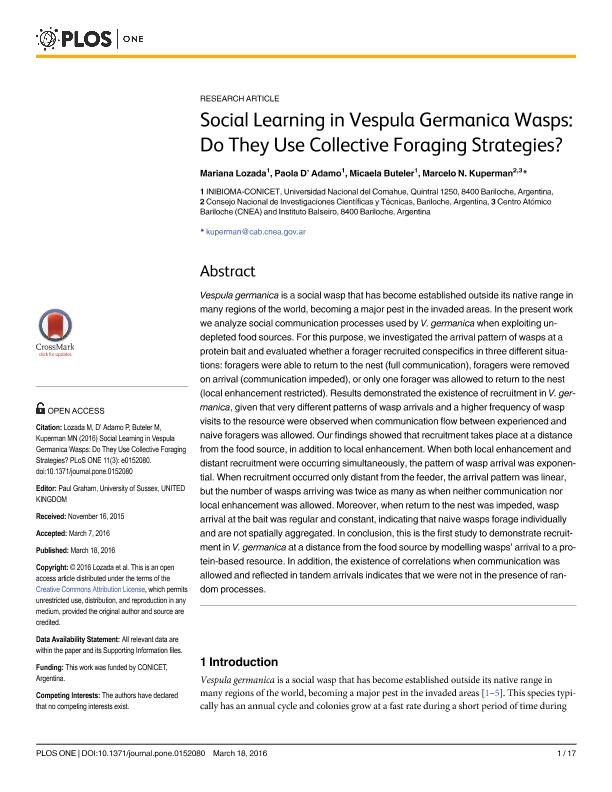Mostrar el registro sencillo del ítem
dc.contributor.author
Lozada, Mariana

dc.contributor.author
D'adamo, Paola

dc.contributor.author
Buteler, Micaela

dc.contributor.author
Kuperman, Marcelo Nestor

dc.date.available
2018-10-12T17:42:42Z
dc.date.issued
2016-03
dc.identifier.citation
Lozada, Mariana; D'adamo, Paola; Buteler, Micaela; Kuperman, Marcelo Nestor; Social learning in vespula germanica wasps: Do they use collective foraging strategies?; Public Library of Science; Plos One; 11; 3; 3-2016; 1-17
dc.identifier.issn
1932-6203
dc.identifier.uri
http://hdl.handle.net/11336/62338
dc.description.abstract
Vespula germanica is a social wasp that has become established outside its native range in many regions of the world, becoming a major pest in the invaded areas. In the present work we analyze social communication processes used by V. germanica when exploiting undepleted food sources. For this purpose, we investigated the arrival pattern of wasps at a protein bait and evaluated whether a forager recruited conspecifics in three different situations: foragers were able to return to the nest (full communication), foragers were removed on arrival (communication impeded), or only one forager was allowed to return to the nest (local enhancement restricted). Results demonstrated the existence of recruitment in V. germanica, given that very different patterns of wasp arrivals and a higher frequency of wasp visits to the resource were observed when communication flow between experienced and naive foragers was allowed. Our findings showed that recruitment takes place at a distance from the food source, in addition to local enhancement. When both local enhancement and distant recruitment were occurring simultaneously, the pattern of wasp arrival was exponential. When recruitment occurred only distant from the feeder, the arrival pattern was linear, but the number of wasps arriving was twice as many as when neither communication nor local enhancement was allowed. Moreover, when return to the nest was impeded, wasp arrival at the bait was regular and constant, indicating that naive wasps forage individually and are not spatially aggregated. In conclusion, this is the first study to demonstrate recruitment in V. germanica at a distance from the food source by modelling wasps' arrival to a protein-based resource. In addition, the existence of correlations when communication was allowed and reflected in tandem arrivals indicates that we were not in the presence of random processes.
dc.format
application/pdf
dc.language.iso
eng
dc.publisher
Public Library of Science

dc.rights
info:eu-repo/semantics/openAccess
dc.rights.uri
https://creativecommons.org/licenses/by-nc-sa/2.5/ar/
dc.subject
Social Communication
dc.subject
Learning
dc.subject
Behavior
dc.subject.classification
Otras Ciencias Biológicas

dc.subject.classification
Ciencias Biológicas

dc.subject.classification
CIENCIAS NATURALES Y EXACTAS

dc.title
Social learning in vespula germanica wasps: Do they use collective foraging strategies?
dc.type
info:eu-repo/semantics/article
dc.type
info:ar-repo/semantics/artículo
dc.type
info:eu-repo/semantics/publishedVersion
dc.date.updated
2018-09-14T14:03:29Z
dc.journal.volume
11
dc.journal.number
3
dc.journal.pagination
1-17
dc.journal.pais
Estados Unidos

dc.journal.ciudad
San Francisco
dc.description.fil
Fil: Lozada, Mariana. Consejo Nacional de Investigaciones Científicas y Técnicas. Centro Científico Tecnológico Conicet - Patagonia Norte. Instituto de Investigaciones en Biodiversidad y Medioambiente. Universidad Nacional del Comahue. Centro Regional Universidad Bariloche. Instituto de Investigaciones en Biodiversidad y Medioambiente; Argentina
dc.description.fil
Fil: D'adamo, Paola. Consejo Nacional de Investigaciones Científicas y Técnicas. Centro Científico Tecnológico Conicet - Patagonia Norte. Instituto de Investigaciones en Biodiversidad y Medioambiente. Universidad Nacional del Comahue. Centro Regional Universidad Bariloche. Instituto de Investigaciones en Biodiversidad y Medioambiente; Argentina
dc.description.fil
Fil: Buteler, Micaela. Consejo Nacional de Investigaciones Científicas y Técnicas. Centro Científico Tecnológico Conicet - Patagonia Norte. Instituto de Investigaciones en Biodiversidad y Medioambiente. Universidad Nacional del Comahue. Centro Regional Universidad Bariloche. Instituto de Investigaciones en Biodiversidad y Medioambiente; Argentina
dc.description.fil
Fil: Kuperman, Marcelo Nestor. Consejo Nacional de Investigaciones Científicas y Técnicas; Argentina. Comisión Nacional de Energía Atómica. Centro Atómico Bariloche; Argentina
dc.journal.title
Plos One

dc.relation.alternativeid
info:eu-repo/semantics/altIdentifier/url/https://journals.plos.org/plosone/article?id=10.1371/journal.pone.0152080
dc.relation.alternativeid
info:eu-repo/semantics/altIdentifier/doi/https://dx.doi.org/10.1371/journal.pone.0152080
Archivos asociados
